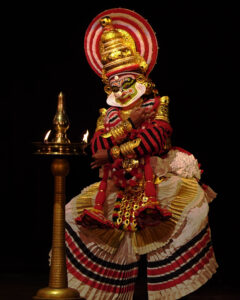Margi Madhu Chakyar is one of the best contemporary artists of Koodiyattam, Sanskrit Theatre art form. He has learned Koodiyattam intensive training from his father Moozhikkulam Kochukuttan Chakyar and uncle, the legendary great Padma Bhushan Guru Ammannur Madhava Chakyar.
Q. Could you tell us about your family lineage and how has it influenced your interest in Koodiyattam?
A. As I come from a traditional family of performers, Koodiyattam has always been a part of my life. Before 1967, Koodiyattam was a traditional art and only the Chakyar community used to play the male characters. My uncle, Padma Bhushan Ammannur Madhava Chakyar, and my father, Padma Shri Moozhikkulam Kochukuttan Chakyar, were both performers, and I had been initiated this art in my childhood. I used to see the performances happening in our temple for 41 days every year. When my father was appointed as the guru in Margi Trivandrum, I was shifted to Trivandrum where I learned from my father and uncle.
Q. Who were some of your gurus or mentors in Koodiyattam, and what were some of the most valuable lessons they imparted to you?
A. My uncle Ammannur Madhava Chakyar was a very tough teacher and did not compromise on any kind of simplification with the art. He moulded my mind and body to be sharp and flexible. At the same time, my father was a teacher with great tolerance and spent his life sharing his knowledge. He did not need to look into books but could recollect everything from memory. Besides these two legendary gurus, I also learned from Narayanan Nambiar and M. Madhavanunni. I was taught that even if I have to cut short the time, the performance should carry the depth akin to how Koodiyattam treats time and space in a play and comments on a character.
Q. How would you describe your personal technique or style when it comes to performing Koodiyattam, and how has it evolved over the years?
A. I believe that imagination is my strength in depicting the characters. My guru taught me to observe my surroundings to enhance the characterization, especially of animals, birds, and nature because even though there is a minimum pattern of movement, the life I give to a character through my imagination makes my own identity stronger and stand out. Otherwise, it would be a mechanical reproduction and not a creative performance. For example, when uprooting the Kailash mountain, my guru Ammanur used to tell me that I must hold the weight in my hand and imagine that the weight is coming to my chest.
Q. What are some of the most important elements or techniques that you focus on when performing Koodiyattam, and how do you bring these to life on stage?
A. Pakarnattam (inter-changing the characters) is a technique we frequently use on stage in Koodiyattam. Within seconds, we must change the style of the characters. Controlling the breath and energy is the only way to switch over quickly. Repetition and imagination are the only ways to fulfill the task. Repetition gives you mastery over the body, and imagination gives you the power to control the mind.
Q. Could you share with us some of your favourite characters to portray in Koodiyattam? Tell us some of your most memorable performances?
A. My favorite character is Ravana because in Koodiyattam, Ravana is constructed through human emotions more than other characters. When we enact Ravana, we must maintain rasa prolonged without breaking its intensity and depth. My most memorable performances have been the full-scale performances in Margi and Nepathya. However, I was pleasantly surprised by the audience’s reaction when I performed at the University of California, Davis, and the University of Harvard, Boston.
Q. How do you see Koodiyattam evolving in the future, and what role do you see yourself playing in promoting and preserving this ancient art form?
A. Despite having a lot of struggle, I believe that Koodiyattam will find its own space in the coming centuries. To mould a dedicated generation, I run my gurukulam, Nepathya. The rare and vast repertoire has been performed and documented through the talented new generation.
As an outreach and awareness program, I conduct many workshops and lecture demonstrations for the new generation. The audience has a significant role in the survival of Koodiyattam.
Q. Finally, could you share with us any upcoming projects or performances that you are particularly excited about, and what do you hope to achieve through them?
A. Currently, I am attempting to revive the complete Pratima Natakam, the ancient Sanskrit drama with Ramayana theme by poet Bhasa (1000 BC) in the repertoire. In this drama, one act is completed in 10 days. If it comes true, the three Ramayana plays will again come live on a performance stage, which last happened in the 19th century. I hope that this project will help to preserve and promote this ancient art form for future generations.
Suman Doonga is an educationist and social worker with a passion to preserve and promote Indian art and culture.














